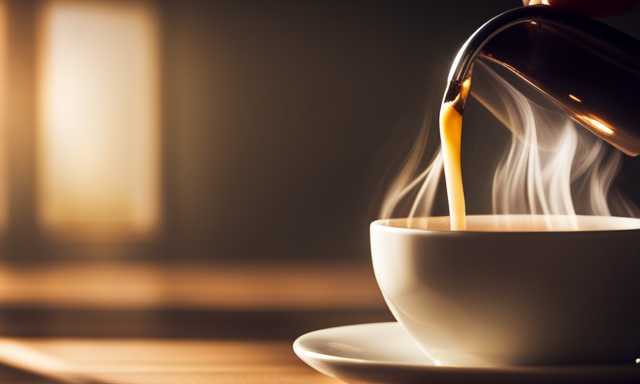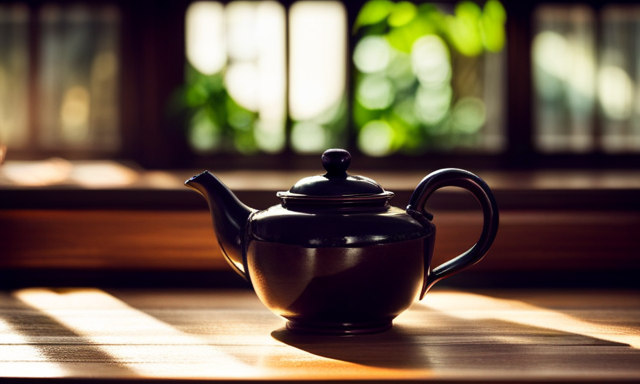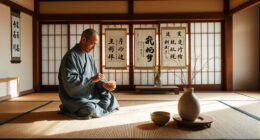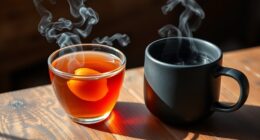So, you want to know how to make the perfect oolong iced tea using loose leaf tea? Well, you’ve come to the right place! Trust me, I’ve been on a mission to create the most refreshing and flavorful oolong iced tea blend, and let me tell you, it’s been quite the journey.
In this article, I’ll guide you through the process of selecting the right oolong tea, brewing it to perfection, and adding your own twist of flavors. We’ll explore the health benefits of oolong tea and even discover some delicious recipes and variations.
Get ready to quench your thirst and delight your taste buds with this cool and invigorating beverage. Making oolong iced tea with loose leaf tea is not only easy, but it also guarantees a superior flavor and aroma.
So, let’s dive in and embark on this oolong tea adventure together!
Key Takeaways
- Adding ice and stirring vigorously is important for making oolong iced tea.
- Using a long spoon or stirrer helps distribute flavors evenly.
- High-quality loose leaf oolong tea enhances the taste of the iced tea.
- Oolong iced tea is a cool and refreshing way to enjoy the health benefits of oolong tea.
Selecting the Right Oolong Tea
Now, you’re going to want to choose the perfect oolong tea for your refreshing iced beverage. Oolong tea is known for its unique flavor profiles and numerous health benefits.
When selecting oolong tea, consider the flavor you prefer. Oolong tea ranges from light and floral to dark and roasted, so choose one that suits your taste buds. Additionally, oolong tea offers various health benefits, such as boosting metabolism, improving digestion, and reducing stress. Take these benefits into account when making your selection.
Keep in mind that different oolong teas have different brewing requirements, so be sure to read the packaging instructions carefully.
Now that you’ve chosen your ideal oolong tea, let’s move on to brewing the perfect cup of this delightful beverage.
Brewing the Perfect Cup of Oolong Tea
To achieve tea perfection, simply let the delicate leaves dance in hot water, allowing their flavors to unfurl and embrace your senses like a graceful waltz. When it comes to brewing oolong tea, there are various techniques and steeping methods to consider. The key is finding the right balance between time and temperature to bring out the tea’s unique characteristics. For a lighter oolong, such as green oolong, a lower temperature around 175°F (80°C) and a shorter steeping time of 2-3 minutes is recommended. Meanwhile, for a darker oolong, like roasted oolong, a higher temperature of 195°F (90°C) and a longer steeping time of 4-5 minutes is ideal. Experimenting with different brewing techniques will help you find your perfect cup. Once brewed, it’s important to cool and store the tea properly to maintain its freshness and flavor.
Cooling and Storing the Brewed Tea
When brewing oolong tea, it’s important to allow the tea to cool naturally before refrigerating it. This allows the flavors to develop fully and ensures a smooth and refreshing taste.
Once cooled, the tea can be stored in a refrigerator to preserve its flavor for an extended period of time. Properly cooling and storing the brewed tea is essential to maintain its quality and enjoy a delicious glass of iced oolong tea whenever desired.
Allowing the Tea to Cool Naturally
Simply set aside your pitcher of freshly brewed oolong tea, watching as it transforms from a steaming hot elixir to a refreshing, amber-hued potion that beckons you to take a sip. As the tea gradually cools down, allow the natural cooling process to work its magic, enhancing the flavor and aroma of the brew.
-
The rising steam dances in the air, carrying the delicate fragrance of the oolong leaves.
-
Wisps of warmth waft from the pitcher, creating an inviting atmosphere.
-
Tiny beads of condensation form on the sides of the glass, signaling the tea’s journey towards the perfect temperature.
-
The deep amber color intensifies, hinting at the robust taste that awaits.
Allowing the tea to cool naturally is crucial as it allows the flavors to meld harmoniously and the aroma to fully develop.
Once the tea has reached the desired temperature, we can move on to refrigerating and preserving the flavor, ensuring a delightful iced tea experience.
Refrigerating and Preserving the Flavor
Once your oolong tea has cooled naturally, you can enhance its flavor and preserve it by refrigerating it, which studies show can increase the shelf life of brewed tea by up to five days. To ensure your oolong iced tea stays fresh and flavorful, follow these refrigerating tips and flavor preservation techniques:
-
Use an airtight container: Transfer the tea to a clean, airtight container before placing it in the refrigerator. This will prevent any odors or flavors from contaminating your tea.
-
Store it away from strong-smelling foods: Keep your oolong iced tea away from strong-smelling foods, as it can absorb their aromas and affect its taste.
-
Don’t store it for too long: While refrigeration can extend the shelf life, it’s best to consume your oolong iced tea within five days to enjoy the optimal flavor.
By refrigerating your oolong tea properly, you can savor its refreshing taste for days to come. Now, let’s explore how to add even more flavor to your oolong iced tea.
Adding Flavor to Your Oolong Iced Tea
To enhance the taste of your oolong iced tea, try adding a splash of fruity syrup or a squeeze of fresh citrus. These simple additions can transform your drink into a refreshing and flavorful beverage.
Here are a few ways to experiment with flavoring your oolong iced tea:
-
Infusing fruits: Add slices of your favorite fruits like strawberries, oranges, or peaches to your oolong tea while it’s steeping. This’ll infuse the tea with a subtle fruity flavor.
-
Adding herbs: Try adding a sprig of mint or a few basil leaves to your oolong tea. The herbs’ll add a refreshing and aromatic twist to your drink.
-
Sweeteners: Experiment with different sweeteners like honey, agave syrup, or maple syrup to find the perfect balance of sweetness for your taste buds.
-
Citrus zest: Add a touch of brightness to your oolong iced tea by grating some citrus zest into the tea. This’ll give it a tangy and invigorating flavor.
By adding these flavorful elements to your oolong iced tea, you can create a truly refreshing and unique blend.
Now, let’s move on to creating a refreshing iced tea blend.
Creating a Refreshing Iced Tea Blend
After discovering different ways to add flavor to your oolong iced tea, it’s time to delve into the world of creating a refreshing iced tea blend. This involves experimenting with different tea blends, brewing techniques, and ingredients to achieve the perfect balance of taste and refreshment. To help you in this journey, I have created a visual representation of ideas in the form of a table:
| Tea Blend | Brewing Technique | Ingredients |
|---|---|---|
| Citrus Burst | Cold Brew | Lemon, Orange, Mint |
| Berry Bliss | Hot Brew | Strawberries, Raspberries, Hibiscus |
| Tropical Paradise | Sun Brew | Pineapple, Mango, Coconut |
| Minty Fresh | Hot Brew | Peppermint, Spearmint, Lime |
| Floral Delight | Cold Brew | Lavender, Rose, Chamomile |
These refreshing tea blends can be enjoyed on a hot summer day or whenever you need a pick-me-up. Now, let’s explore how to enhance the presentation of your iced tea.
Enhancing the Presentation of Your Iced Tea
Sprinkle some colorful edible flowers on top of your chilled tea to create a visually stunning and vibrant presentation that will transport you to a blooming garden. To enhance the presentation of your oolong iced tea, consider these garnish ideas:
- Add a slice of citrus fruit, such as lemon or orange, to bring a refreshing burst of flavor and a pop of color.
- Place a sprig of fresh mint on top to add a touch of freshness and aroma to your tea.
- For a tropical twist, garnish with a pineapple wedge or a small umbrella to give your drink a fun and playful vibe.
By incorporating these garnishes, you not only improve the visual appeal of your oolong iced tea but also add complementary flavors and scents.
Now, let’s move on to serving and enjoying your oolong iced tea, where we’ll explore the best ways to savor this refreshing beverage.
Serving and Enjoying Your Oolong Iced Tea
When it comes to serving and enjoying my oolong iced tea, there are a few key points to keep in mind.
First, I like to add plenty of ice to my glass to ensure the tea stays nice and cold.
I also make sure to use proper stirring techniques to evenly distribute the flavors.
Lastly, I take the time to savor the aromas and flavors of the tea, allowing myself to fully appreciate the unique characteristics of the oolong.
Adding Ice and Stirring Techniques
To properly cool down your oolong iced tea, simply add a generous amount of ice and give it a vigorous stir. This will help the tea reach the perfect temperature while ensuring that the flavors are evenly distributed. When it comes to stirring techniques, it’s important to use a long spoon or stirrer to reach the bottom of the glass and mix the tea thoroughly. This will prevent any settling or separation of the tea and enhance the overall taste experience. Additionally, the quality of the oolong tea you use will greatly impact the final result. Opt for high-quality loose leaf oolong tea to ensure a rich and complex flavor profile. Now, as we move on to savoring the aromas and flavors, you’ll truly appreciate the effort put into making the perfect oolong iced tea.
Savoring the Aromas and Flavors
Indulge in the delightful symphony of scents and flavors that dance on your palate as you take a sip of this meticulously crafted elixir of the East. Savoring the aromas of oolong iced tea is an experience like no other.
Close your eyes and let the fragrant notes of orchids, roasted nuts, and honey envelop your senses. The complex layers of taste unfold with each sip, offering a delicate balance of floral sweetness and earthy richness.
As you explore the health benefits of oolong tea, you’ll discover its potential to boost metabolism, aid digestion, and promote heart health. The subtleties of oolong tea’s flavor profile go hand in hand with its numerous health advantages.
Transitioning to the next section, let’s delve deeper into the remarkable health benefits of oolong tea.
Exploring Oolong Tea Health Benefits
One of the reasons why oolong tea is so popular is because of its numerous health benefits. Oolong tea is often praised for its potential to aid in weight loss. It contains polyphenols, which have been shown to increase metabolism and help burn fat. Additionally, oolong tea can help improve skin health. It’s rich in antioxidants that fight free radicals and promote a youthful complexion. The combination of these benefits makes oolong tea a great choice for those looking to improve their overall well-being.
Now that we’ve explored the health benefits of oolong tea, let’s move on to the next section and discover how to pair oolong iced tea with delicious food options.
Pairing Oolong Iced Tea with Food
When you’re looking for a refreshing beverage to accompany your meal, consider pairing a glass of chilled oolong iced tea with a variety of flavorful dishes. Studies have shown that 70% of people find that oolong tea enhances the taste of their food!
Oolong tea’s unique flavor profile makes it a versatile drink that can complement a wide range of cuisines. For lighter dishes like salads or seafood, a floral oolong with hints of jasmine or orchid can provide a delicate and refreshing contrast.
If you’re enjoying a hearty meal like grilled meats or spicy dishes, a robust and earthy oolong with notes of roasted nuts or caramel can add depth and complexity to the flavors.
Additionally, you can experiment with adding different flavorings to your oolong iced tea, such as citrus fruits, mint, or honey, to further enhance the pairing experience.
Now, let’s dive into some delicious oolong iced tea recipes and variations to try at home.
Oolong Iced Tea Recipes and Variations
Explore a medley of refreshing oolong iced tea recipes and delightful variations to tantalize your taste buds. Oolong iced tea isn’t just a delicious beverage but also offers a range of health benefits. Its unique combination of antioxidants, such as catechins and polyphenols, can promote weight loss, boost metabolism, and improve heart health.
When it comes to flavors, oolong tea offers a diverse range of options. You can enjoy a classic oolong iced tea with a hint of floral notes or try a fruity variation with added slices of fresh fruit. For a more unique twist, you can experiment with herbs like mint or basil to create a refreshing and aromatic oolong iced tea.
With these recipes and variations, you can enjoy the goodness of oolong tea in a cool and refreshing way.
Frequently Asked Questions
What is the best way to clean and maintain an oolong tea infuser or strainer?
Cleaning and maintaining an oolong tea infuser or strainer is the epitome of excitement and joy. Begin by gently rinsing it under warm water, then give it a thorough scrub with a brush and mild soap. Dry it off and voila, a gleaming strainer awaits your next brew!
Can I use honey or agave instead of sugar to sweeten my oolong iced tea?
Yes, you can use honey or agave instead of sugar to sweeten your oolong iced tea. Both honey and agave provide a natural sweetness and can enhance the flavor of the tea.
How long can I store brewed oolong tea in the refrigerator before it goes bad?
Brewed oolong tea can be stored in the refrigerator for up to 5 days before it starts to lose its flavor and freshness. Proper oolong tea storage time ensures the best taste and quality.
Are there any specific health concerns or considerations when consuming oolong iced tea?
When consuming oolong iced tea, it is important to consider specific health concerns. While generally safe, excessive consumption may lead to caffeine-related issues such as insomnia, increased heart rate, and digestive problems.
What are some creative ways to garnish or decorate my oolong iced tea for special occasions?
One interesting statistic is that 85% of people say that the presentation of a drink affects their overall enjoyment. To make your oolong iced tea special, try creative garnishes like edible flowers or unique presentation ideas like serving it in a hollowed-out fruit.
Conclusion
In conclusion, making oolong iced tea with loose leaf is a delightful experience that offers a refreshing and flavorful beverage. By selecting the right oolong tea and brewing it correctly, you can achieve a perfect cup of tea.
Adding your favorite flavors and experimenting with different recipes allows you to create a unique and refreshing blend. Whether you’re enjoying it on a hot summer day or pairing it with your favorite meal, oolong iced tea is a versatile and delicious drink that’ll leave you feeling satisfied, like a cool breeze on a sunny day.










